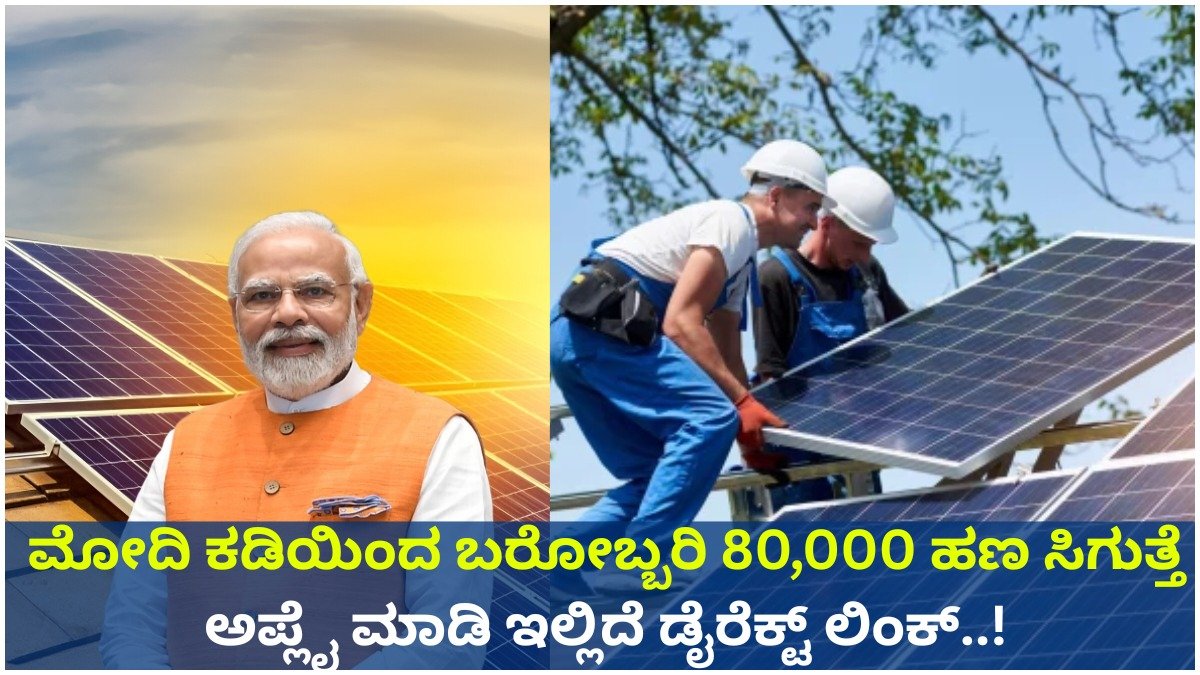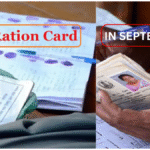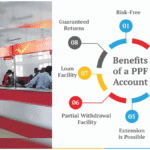1. Introduction
India is blessed with abundant sunlight across most of its regions for nearly 300 days a year, giving it one of the world’s best potentials for solar energy generation. Recognizing this opportunity, the Government of India launched the PM Surya Ghar: Muft Bijli Yojana in 2024 under the leadership of Prime Minister Narendra Modi.
This scheme is designed to bring the benefits of solar power directly to Indian households by encouraging *rooftop solar panel installations. The vision is to enable *one crore homes to produce their own clean electricity, thereby providing up to 300 units of free power per month and moving the country toward sustainable energy independence.
2. What Is the PM Surya Ghar Scheme?
The PM Surya Ghar: Muft Bijli Yojana is a central government flagship program aimed at promoting the use of rooftop solar systems for residential electricity needs. The idea is simple: households can generate their own energy, reduce their reliance on traditional electricity sources, and save on monthly bills.
Key aspects include:
- Solar panels installed on rooftops of eligible homes.
- Central government subsidies to make installation cost-effective.
- Free electricity benefit of up to 300 units each month.
The scheme is not just about subsidies—it’s about empowering citizens, protecting the environment, and building a future where clean energy becomes the norm.
3. Main Objectives of the Scheme
The program has several interconnected goals:
- Lower Household Electricity Costs
By producing their own power, families can significantly cut monthly bills. - Boost Renewable Energy Adoption
Encouraging solar power helps increase its share in India’s overall energy production. - Citizen Empowerment
Families gain the independence to generate and manage their own electricity. - Job Creation
The scheme drives demand for skilled workers in installation, servicing, and solar manufacturing. - Environmental Protection
By reducing carbon emissions, it contributes to India’s commitments toward net-zero targets.
4. Key Features of PM Surya Ghar Yojana
- Target Reach: 1 crore households.
- Free Power Benefit: 300 units per month.
- Government Subsidy: Up to ₹78,000 for a 3 kW rooftop system.
- Application Portal: pmsuryaghar.gov.in for online registration.
- Easy Loan Availability: Financial institutions offer low-interest loans for installation.
- Real-Time Monitoring: Smart meters and mobile apps track electricity generation and usage.
5. Eligibility Criteria
To qualify for the scheme, applicants must meet the following conditions:
- Must be an Indian citizen.
- Should own a residential property with a suitable rooftop for solar installation.
- The electricity connection must be in the applicant’s name.
- Should not have availed any rooftop solar subsidy earlier.
- No pending dues with the local DISCOM (electricity provider).
6. How the Scheme Works
The implementation process follows a clear, step-by-step structure:
- Online Registration via the official portal.
- Application Verification by the local DISCOM.
- Selection of an Authorized Vendor from the approved list.
- Installation of Solar Panels according to specifications.
- Inspection and Commissioning by DISCOM officials.
- Subsidy Disbursal directly to the beneficiary’s bank account.
7. Financial Assistance Details
The government provides direct subsidies based on the solar system’s capacity:
| Capacity | Subsidy Amount |
|---|---|
| Up to 2 kW | ₹30,000 |
| 3 kW System | ₹78,000 |
| Above 3 kW | ₹78,000 (fixed) |
This subsidy is transferred after installation and verification, ensuring transparency.
8. Benefits of the Scheme
For Households
- Drastically reduced or zero monthly electricity bills.
- Independence from rising grid electricity prices.
- Savings of ₹1,000–₹2,000 per month.
For the Nation
- Reduced dependence on imported fossil fuels.
- Lower greenhouse gas emissions.
- Improved energy security.
For the Economy
- Expansion of the green jobs sector.
- Boost to domestic solar panel and component manufacturing industries.
9. How to Apply for the Scheme
Step-by-Step Registration Process:
- Visit the official website: pmsuryaghar.gov.in.
- Choose your DISCOM and provide your electricity connection details.
- Create an account and fill out the application form.
- Select an empaneled vendor for installation.
- Complete the installation process and net-metering setup.
- Get your system inspected and approved by DISCOM.
- Submit bank account details for subsidy credit.
10. Documents Required
- Aadhaar Card
- Latest Electricity Bill
- Proof of Property Ownership
- Bank Passbook (for subsidy transfer)
- Passport-size Photograph
- Email ID and Mobile Number
11. Installation Process
- Site Survey – Assessing the rooftop and designing the system.
- Design Approval – Getting technical approval from authorities.
- Installation – Setting up panels, inverter, and wiring.
- Inspection & Net Metering – DISCOM verification and meter installation.
- Activation – Connecting the system to the grid.
- Monitoring Setup – Configuring mobile app or portal access.
12. Roles of Key Stakeholders
- DISCOMs: Verify applications, conduct inspections, manage net metering.
- MNRE: Formulates policies, disburses subsidies, and monitors progress.
- Vendors: Install and maintain rooftop solar systems.
- Banks/NBFCs: Provide loans to interested households.
13. Budget and Funding
The scheme operates under the Viksit Bharat @2047 mission, with a budget allocation of ₹75,000 crore.
Funds are utilized for:
- Subsidy payments to beneficiaries.
- Infrastructure development for solar integration.
- Training and awareness programs to boost adoption.
14. Technology Specifications
- Panel Types: Monocrystalline or Polycrystalline.
- Efficiency Range: 18%–22%.
- Inverter: Converts DC electricity to AC for household use.
- Smart Meter: Tracks generation and consumption in real time.
- Warranty: Panels generally carry a 25-year performance warranty.
15. Role of MNRE and State Governments
- MNRE (Ministry of New and Renewable Energy): Oversees policy framework, sets subsidy rules, and monitors implementation.
- State Nodal Agencies: Coordinate with vendors and conduct awareness campaigns.
- Local Bodies (Panchayats, ULBs): Promote the scheme within communities.
16. Environmental Advantages
- Carbon Emissions Reduction: Prevents millions of tons of CO₂ annually.
- Water Conservation: Solar generation requires less water than coal-based plants.
- Improved Air Quality: Reduces particulate pollution in both rural and urban areas.
17. Economic Impact
- Over 1 lakh green jobs expected in installation, servicing, and manufacturing.
- Stimulates domestic solar equipment production.
- Cuts down the government’s burden of electricity subsidies.
18. Impact in Rural and Urban Areas
Rural Impact:
- Brings electricity to off-grid homes.
- Supports irrigation through solar-powered pumps.
Urban Impact:
- Reduces pressure on city power grids.
- Cuts electricity bills for densely populated housing.
19. Real-Life Success Stories
- Rajasthan: Ram Singh installed a 3 kW system and saves around ₹1,800 per month.
- Uttar Pradesh: Savitri Devi now enjoys free power for household use and actively encourages neighbors to adopt solar.
20. Challenges in Implementation
- Limited awareness among rural populations.
- Unreliable vendors in some areas.
- Delays by DISCOMs in approving net metering.
- Resistance from homeowners about rooftop modifications.
21. Government Steps to Address Challenges
- Launching toll-free helplines and support centers.
- Introducing vendor rating systems for quality assurance.
- Conducting large-scale training programs.
- Running awareness drives through media and local outreach.
22. Maintenance Tips for Solar Panels
- Clean panels at least once a month to remove dust.
- Have an annual inspection by trained technicians.
- Regularly check inverter performance.
- Monitor daily output using the mobile app.
23. Myths vs. Facts
| Myth | Fact |
|---|---|
| Solar doesn’t work in monsoon | Solar still produces electricity in cloudy conditions. |
| It’s too costly | Subsidy covers a major portion of costs. |
| Needs a large rooftop | 1 kW requires about 100 sq. ft of space. |
| Hard to maintain | Requires minimal upkeep. |
24. Frequently Asked Questions
Q1. What is the maximum subsidy amount?
A. ₹78,000 for a 3 kW system.
Q2. Can I sell extra power?
A. Yes, surplus energy can be sold to the grid through net metering.
Q3. Is loan financing available?
A. Yes, participating banks and NBFCs offer loans for installation.
Q4. Do I need a separate meter?
A. Yes, a smart net meter is required.
Q5. Can tenants apply?
A. Yes, if the electricity connection is in their name and they have the owner’s consent.
25. Conclusion
The PM Surya Ghar: Muft Bijli Yojana is more than a subsidy—it’s a transformative movement toward self-reliance, environmental care, and financial savings for Indian households. By tapping into the sun’s endless energy, citizens can cut costs, contribute to climate goals, and help build a greener India.
With government backing, easy loan options, and significant long-term benefits, now is the perfect time for households to adopt rooftop solar energy. The program is not just about free electricity—it’s about shaping a cleaner, brighter future for generations to come.










